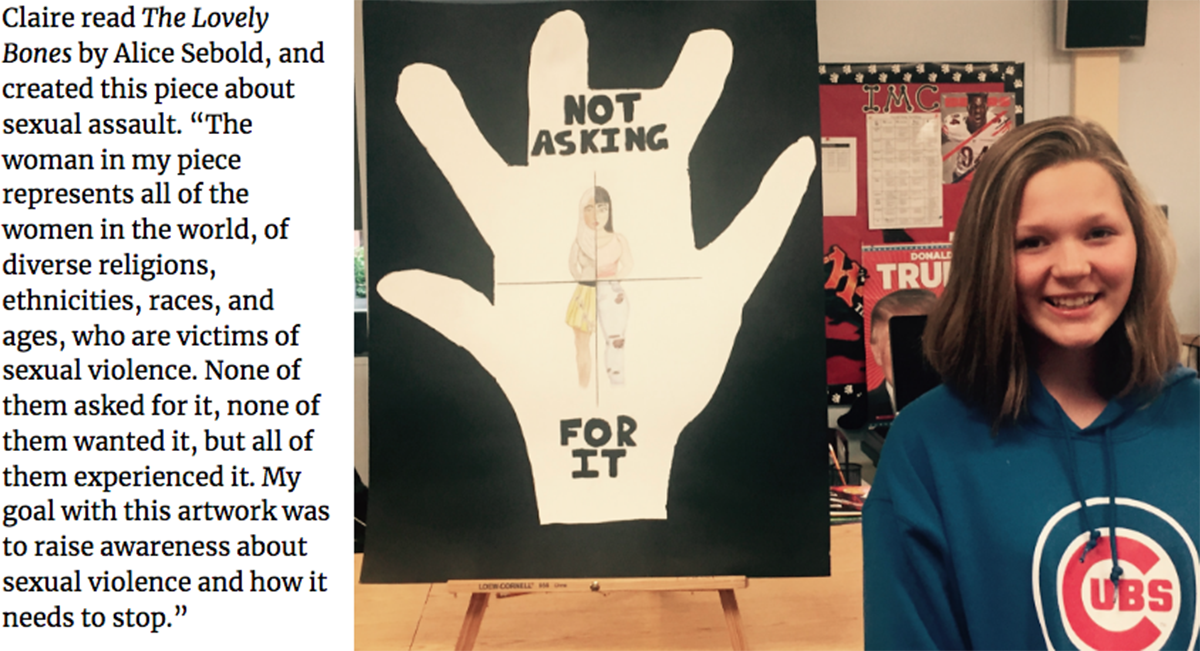Socially Engaged Art via Banned Books
By Ellie Ryan
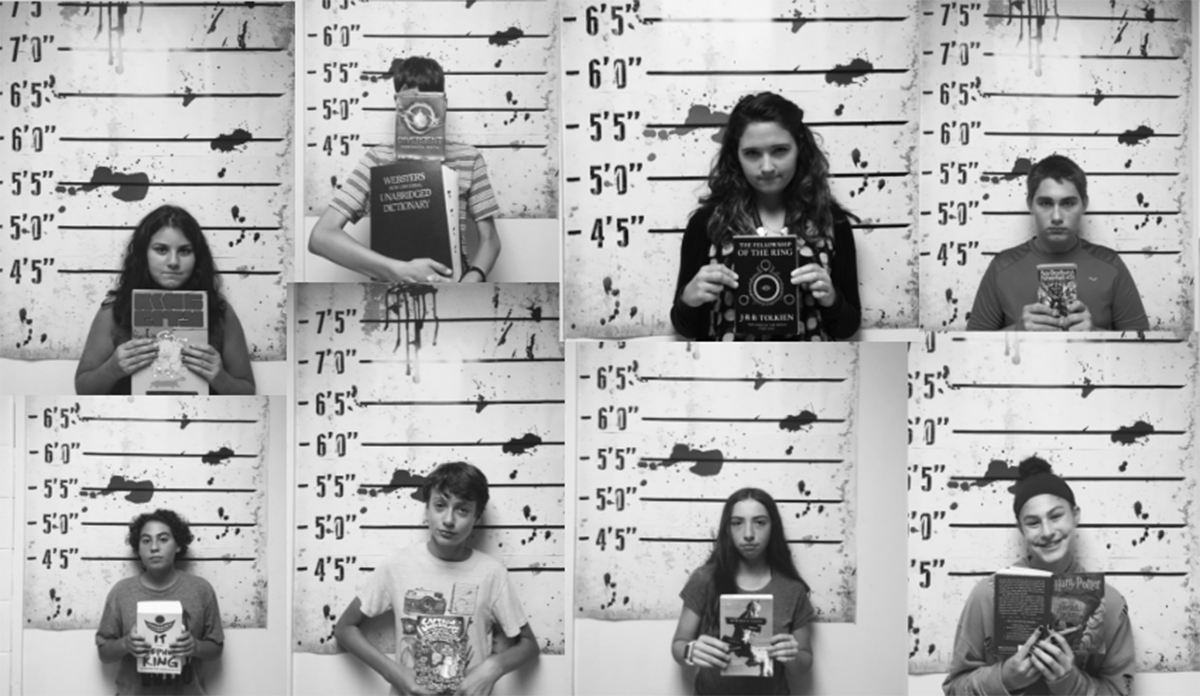
Students in an eighth grade English course at Northwood Junior High explored controversial issues in society through their study of banned books. Students investigated the issues raised by banned books and created works of art that expressed their understanding of and position on the censorship of the ideas represented in the books. Students installed their works in the gallery for a public art show and engaged teacher and community members in dialogue about censorship and the expression of ideas.

Goals
- Engage students through independent reading.
- Create a platform for students to share opinions through art.
- Expose our community to a spectrum of opinions and topics.
Guiding Questions
- What social issue does your banned book tackle?
- Why or why don't you believe your book should be banned?
- How will you explore the controversial idea(s) in the book through art?
- How do artists engage members of a community in thinking about social issues?
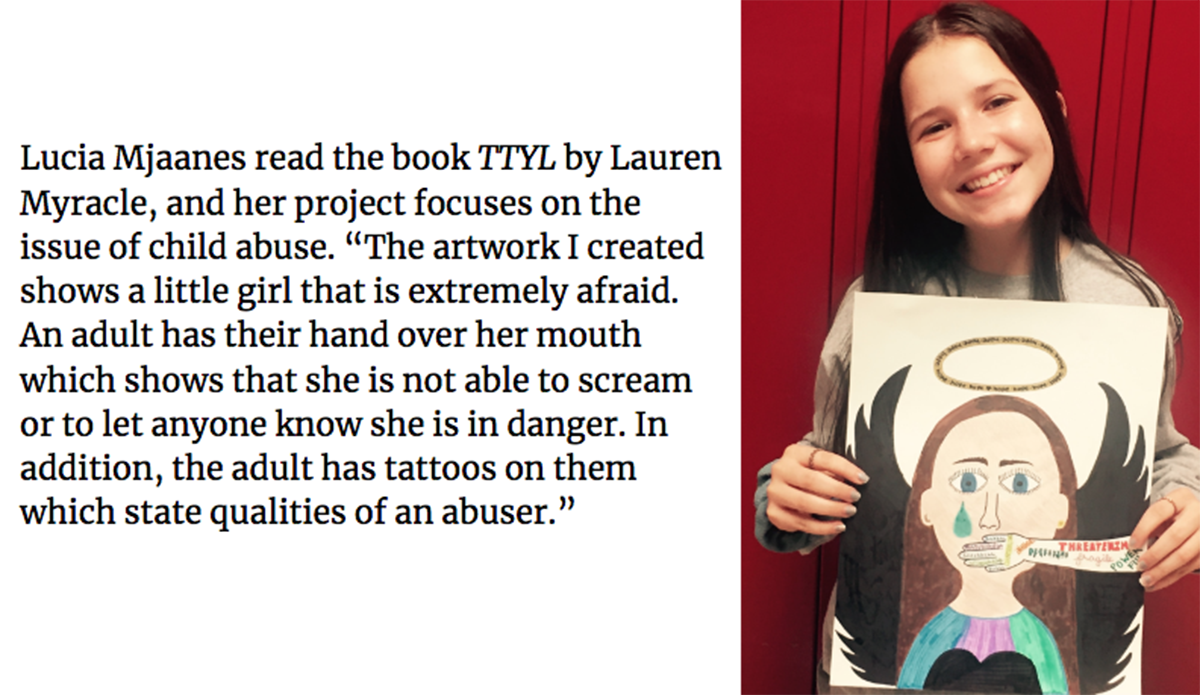
Documentation + Assessment Strategies
Much of the documentation was writing-focused. Students used reflective, analytical, and editorial writing. Students documented the different stages of their project through book writes and journals. Students also photographed themselves, created banned book mugshots, and wrote artist statements about their exploration.
Students helped to design a rubric that aligned with project goals when we first began our exploration.
Rubric
Paragraph
- ___/ 5 Written paragraph has a clear claim explaining how the artwork prompts social
change relevant to and inspired by the book. - ___ / 10 Reasons with specifics from the artwork and the book support the claim and prompt social change.
- ___ / 5 Conclusion reasserts the claim with new insight and different language.
- ___ / 5 Writing style includes sophisticated vocabulary and sentence structure. Figurative
language and/or repetition are effectively included in the writing.
Book Write
-___ / 10 Completed with responses revealing deep reading.
- ___ / 5 Connection between the book and social issues is supported with logic and specifics
from the book.
Artwork
- ___ / 10 Artwork reflects the social issues from the book offering visual commentary and/or
a possible solution. - ___ / 10 Message of the artwork is appropriate for the general public.
-___ /60 (Total)
Voting
Students worked with teachers to create a voting ballot for the final artwork exhibition. Students and community members voted separately on the ballots for the final artwork exhibition, which allowed students to assess the differing views of these two groups regarding the success of their artistic statement.
Learning Activities
Timeframe
Two months, roughly 20 minutes a day.
SETTING THE STAGE
I teach at a Title I school in the north suburbs of Chicago. Our school serves a diverse community of learners including 48.3% Latino, 44.6% low income, 17% ELS, 14% IEP, and 4.4% Chronically truant students. I created an environment conducive to exploring censorship and socially engaged art by establishing relationships with students early on, and encouraging them to take risks. We develop our curriculum around student choices and interests, and make sure to update sources and texts accordingly. Our class worked together to define the phrase ‘socially engaged art’ and to find corresponding pieces of literature to serve as the basis of their projects.
STEP 1
Banned Book Exploration
Students survey popular banned books to find out how many they've already read and how many children's books have been banned. Teacher leads group discussion about why books are banned and what topics or ideas have been banned.
STEP 2
How are Books Banned?
The school librarian and the public librarian give presentations that provide further insight into banning books, explaining the process and examples. Back in the classroom, the teacher leads students in further conversations around what is banned within our school, and identify possible subjects to explore via projects. Encourage discussion around online censorship, boundaries, and vulnerabilities.
In our discussions, students mentioned that movies and novels were being removed from the curriculum this year.
STEP 3
Explore Controversial Ideas
Students individually select a banned book to read for the quarter, based on their exploration of the history and process of banning controversial ideas in Steps 1 and 2.
STEP 4
What is Socially Engaged Art?
Provide students examples of socially engaged artworks produced in a variety of media, including graffiti, sculptures, community outreach actions, and political art installations. Introduce artworks by Amanda Williams and Michael Rakowitz as examples of how artists address controversial and provocative ideas in their artwork. Lead student discussion in determining the qualities of socially engaged art, emphasizing that this type of artwork is conceptually driven and involves active participation by the community.
STEP 5
What Makes an Idea Controversial?
Give students the summative challenge of creating a work of art that explores the controversial content of their books. Ask students to take a position on the idea(s) within their banned books and express their position on this idea and/or the censorship of this idea to a public audience. Students begin to generate ideas on how to accomplish this challenge.
STEP 6
Visiting the MCA
Students explore socially engaged artworks at the MCA. Artist Guides lead inquiry-based dialogues with students that provide meaningful insight into how contemporary artists deal with controversial social issues in their artworks.
STEP 7
Making a Statement
Students use a medium of their choice to complete their artwork, designed to make a particular statement about a controversial idea to the specific audience of their school community. The text students chose to read serves as the basis of their thesis statement and project exploration. Some examples include:
- My artwork demonstrates not only how difficult it is to have people of your community be killed in the first place, but also not being able to speak up about it.
- My sculpture says that the way you handle your human instincts, and therefore contribute to the world, is entirely up to you.
- My drawing represents exclusion, conscious and subconscious racism, and how, as you get older, the more you drift from people less like yourself.
- My project is relaying the message that racism and bad treatment of African-Americans still hasn’t changed even though many people have been working for a very long time to change things.
STEP 8
Exhibition
Students curate an exhibition of their completed projects in the library and invite other classes to tour the gallery. Some pieces welcome visitors to interact, while other pieces simply prompt conversation.
In this case, the room was full of noise, and art was displayed on many different physical levels, which made the atmosphere more playful and intriguing. Students and teachers reported feeling inspired, triggered, and proud to be a part of our school.
STEP 9
Welcoming the Community
Community members tour the gallery and participate as jurors to determine the winners of the art exhibition. Winners are selected by popular audience vote and/or by a panel of teachers and staff members who are invited based on their expertise, including the art teacher, school counselors, administrators, and all three eighth grade ELA teachers. The teacher determines the criteria collaboratively with students prior to the gallery tour.
In this exhibition, we awarded five students, with a combination of winners selected by audience vote and by the judging panel. The criteria we chose for this exhibition included: Does the artwork clearly make a statement about social justice? Does the original piece creatively project ideas? Is the piece moving? Does it draw you in and prompt a response? It should not be necessary to read the paragraph to understand the artwork.
STEP 10
Extending the Conversation
Winning art pieces are displayed throughout our district in libraries, display cases, and in conference rooms, in an effort to continue broader community dialogue on the nature of controversial ideas and their historical and contemporary relevance.
In the future, we hope to create more formal and public spaces for display throughout our district. We have discussed the possibility of having student work displayed in the Crown Room or some part of the MCA as a way to fully integrate student voices; they wanted to see themselves represented within the walls of the institution. This could also be done online.

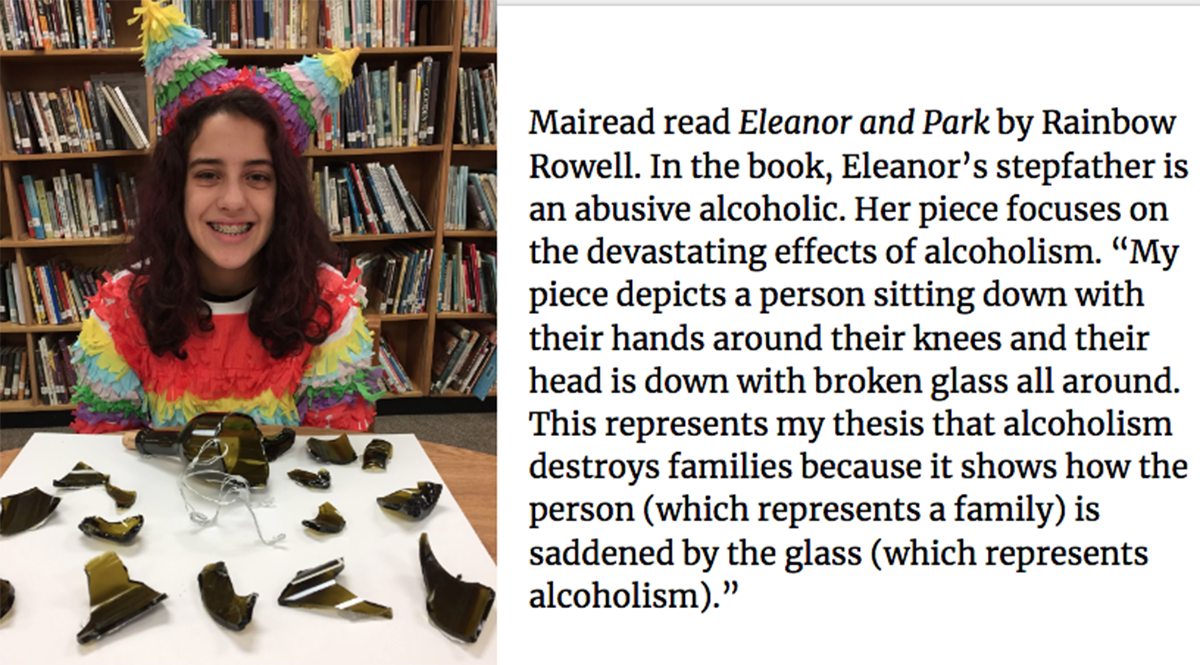
Materials
- Printer paper
- Construction paper
- Printer (and ink)
- Road maps
- Magazines
- Canvas
- Paint
- Modeling clay
- Wood
- Spray paint
- Cameras
- Glitter
- Glue
- Glass bottles
- Paperclips
- Markers
- Watercolor
- Photos
- Mixed media
MCA Connections
The work in Amanda Williams’ Color(ed) Theory and Michael Rakowitz’s Backstroke of the West exhibitions influenced our project and prompted class discussion on how artworks can convey ideas.
Our field trip took place the week before our project was due, so it was the final push of inspiration for many students. We took advantage of the opportunity to work with Artist Guides, who led the students on an hour-long tour of several exhibitions. Although it required significant planning, we took the entire eighth grade on the field trip. We are located on the North Shore and many of our students from low-income backgrounds had never been downtown or to an art museum. It was a very formative experience for them. Students struggled to grasp the concept of socially engaged art for much of the quarter. The museum finally afforded them the ‘aha’ moment they needed to create art themselves.
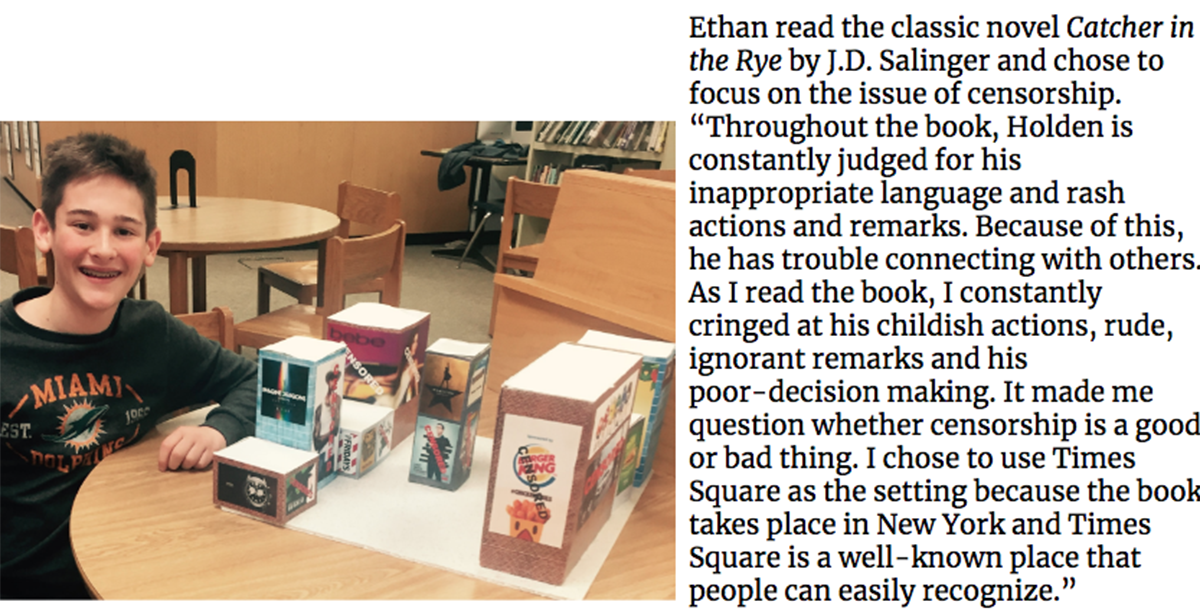
References + Resources
Ellie Ryan
Northwood Junior High School
About Ellie Ryan
Ellie Ryan is currently serving as an English Language Arts and Humanities teacher at Northwood Junior High School in Highland Park. She grew up in the suburbs of Chicago, graduated from Augustana College in the Quad Cities, and began her teaching career in Torreon, Mexico. When she is not teaching, planning, grading, or working on her master's coursework, she enjoys reading, cooking, running, drawing, and spending time with her cats, Salsa and Bowie. She is an avid Harry Potter fan and a music snob. She hopes to find new ways to engage her students through the lenses of protest art, banned books, and media literacy.
Ellie Reflects on the Project
Students had a difficult time grasping the concept of socially engaged art and planning for their projects. Next year we will install check-ins throughout the quarter to ensure they are all on track. We may also opt for a field trip closer to the midway point in the quarter if possible, because visiting the MCA really opened students’ eyes to how artists address social issues, and provided meaningful incentive to create art.
Students provided us with constructive criticism, with praise for the field trip to the museum and Millenium Park, but also with a plea for more time to explore both places. Some students felt their guides were dynamic speakers, while others struggled to connect with the art or their guide.
Throughout the project, students became increasingly aware of the progressive mindset governing our community, and the many opportunities this affords them in studying different materials. They came to realize that other students in more restrictive communities may not experience this same exposure. However, during the course of the project, the school became more censored as well, due to a change in administrative policies. The projects, having been juried by the student’s peers, administrators, and social workers, allow for actual, facilitated conversation around the new censorship students experienced in their own education.
We also saw a huge transformation in our students when we removed them from the school setting. Many of the students were already focusing on income inequality and poverty for their projects, but the field trip really forced our affluent students to confront the privileges of their childhood. Many of our low-income students had never seen buildings so high or spaces dedicated to public art. The project allowed students from different backgrounds to reconsider their perspectives alongside their exploration of controversial historical and contemporary social issues.
